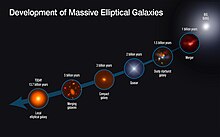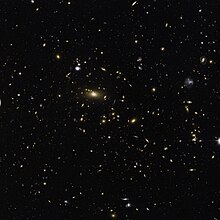利用者:Nova replet laetitia/sandbox/宇宙・物理・自然科学/楕円銀河
 | ここはNova replet laetitiaさんの利用者サンドボックスです。編集を試したり下書きを置いておいたりするための場所であり、百科事典の記事ではありません。ただし、公開の場ですので、許諾されていない文章の転載はご遠慮ください。 記事がある程度できあがったら、編集方針を確認して、新規ページを作成しましょう。 |
en:elliptical galaxy (06:12,18 June 2014 UCT)の版


楕円銀河 (だえんぎんが、英: elliptical galaxy)は、渦巻銀河、レンズ状銀河とともに、主要な3つの銀河分類のうちの1つ[1]。滑らかなおよそ楕円形の形状を持ち、輝度プロファイルにほとんど特徴がない。球形に近い形から非常に扁平なものまであり、内部に1000万から1兆個以上の星を含む。エドウィン・ハッブルは当初は楕円銀河が渦巻銀河へ進化すると考えていたが、後にこれは間違いであることがわかった[2]。楕円銀河内の星は渦巻銀河のものよりも非常に古いことが知られている[2]。
多くの楕円銀河では、星は古く低質量で、星間物質は希薄であり、最小限の星形成活動しかみられず、非常に多くの球状星団が取り囲んでいるという特徴の傾向が見られる。乙女座超銀河団では、属する銀河の 10 - 15% がこの楕円銀河であると考えられているが、全宇宙の銀河の主要なタイプではない[3]が、銀河団の中心へ近づくにつれてよく見られるようになる[4]。楕円銀河はレンズ状銀河とともにハッブル分類の名残で”早期型銀河 英: early-type galaxies、ETG と呼ばれることがあるが、宇宙の初期には一般的でなかったことが判明している。
楕円銀河は以下のような特徴を持つ。
- 銀河全体の角運動量が非常に小さい。
- 星間物質が非常に少ない、もしくは含まれない。若い星や散開星団が存在しない。
- 種族IIと呼ばれる古い星から構成されている。
- 大きな楕円銀河は球状星団系を持っていることが多い。
伝統的な楕円銀河の描像では、楕円銀河は銀河形成初期のスターバーストによって星間物質を失い、星形成が行われなくなった銀河であるとされている。従って、楕円銀河の内部では目に見えるような進化過程は起こっておらず、銀河を構成する星がただ年老いていくだけであると考えられてきた。
しかし近年の観測によって、いくつかの楕円銀河に若く青い星団が発見されるようになった。それとともに、銀河の衝突・合体過程によって説明されるような構造も楕円銀河の内部に見つかっている。これらの観測結果を受けて最近の新しい理論では、楕円銀河は様々なタイプの小さな銀河が長い時間をかけてより大きな銀河へと衝突・合体した結果作られたのではないか、というモデルも提唱されている。
このような合体過程はごく最近または現在でも続いている可能性もあり、その場合には巨大楕円銀河の形成過程に限らず、楕円銀河の起源を広く説明するものかもしれないと考えられている。例として我々の銀河系も、大マゼラン銀河・小マゼラン銀河という2つの小さな銀河を呑み込みつつあることが知られている。
外部リンク
[編集]- Elliptical Galaxies, SEDS Messier pages
一般的な特徴
[編集]
Elliptical galaxies are characterized by several properties that make them distinct from other classes of galaxy. They are spherical or ovoid masses of stars, starved of star-making gases. The smallest known elliptical galaxy is about one-tenth the size of the Milky Way. The motion of stars in elliptical galaxies is predominantly radial, unlike the disks of spiral galaxies, which are dominated by rotation. Furthermore, there is very little interstellar matter (neither gas nor dust), which results in low rates of star formation, few open star clusters, and few young stars; rather elliptical galaxies are dominated by old stellar populations, giving them red colors. Large elliptical galaxies typically have an extensive system of globular clusters.[5]
楕円銀河は、銀河系の他のクラスからそれらが別個にするいくつかの特性を特徴とする。彼らは星の意思ガスが不足星、球状または卵形の塊である。最小の既知の楕円銀河は約10分の1のサイズである天の川。楕円銀河の星の動きは、ディスクとは異なり、主に放射状のある渦巻銀河に支配されて、回転。さらに、ほとんどありません星間物質の低料金になる(ガスや塵もない)、星形成、いくつかのオープン星団、およびいくつかの若い星は、むしろ楕円銀河を支配されている古い恒星の集団彼らに赤い色を与え、。大楕円銀河は、通常の大規模なシステムがある球状星団を。[ 5 ]
The dynamical properties of elliptical galaxies and the bulges of disk galaxies are similar, [6] suggesting that they are formed by the same physical processes, although this remains controversial. The luminosity profiles of both elliptical galaxies and bulges are well fit by Sersic's law.
楕円銀河の力学特性及びバルジのディスク銀河は、類似している[ 6 ]、これは議論の余地があるが、それらは同じ物理的プロセスによって形成されていることを示唆している。輝度楕円銀河とバルジの両方のプロファイルがによく適合しているSersicの法則。
Elliptical galaxies are preferentially found in galaxy clusters and in compact groups of galaxies.
楕円銀河は、優先的に発見された銀河団や銀河のコンパクトなグループに。
星の形成
[編集]The traditional portrait of elliptical galaxies paints them as galaxies where star formation finished after an initial burst at high-redshift, leaving them to shine with only their aging stars. Elliptical galaxies typically appear yellow-red, which is in contrast to the distinct blue tinge of most spiral galaxies. In spirals, this blue color emanates largely from the young, hot stars in their spiral arms. Very little star formation is thought to occur in elliptical galaxies, because of their lack of gas compared to spiral or irregular galaxies. However, in recent years, evidence has shown that a reasonable proportion (~25%) of these galaxies have residual gas reservoirs[7] and low level star-formation.[8] Researchers with the Herschel Space Observatory have speculated that the central black holes in elliptical keep the gas from cooling enough for star formation.[9]
楕円銀河の伝統的な肖像画は銀河としてそれらをペイント星形成が唯一の彼らの高齢化の星と輝くためにそれらを残して、高赤方偏移での初期バースト後の完成。楕円銀河は、通常、ほとんどの明らかな青みとは対照的である、黄赤色に表示さ渦巻銀河。スパイラルでは、この青色は、そのスパイラルの腕の中で若い、ホットスターから大きく発する。非常に小さな星形成があるため、スパイラルまたは不規則銀河に比べてガスの欠如のため、楕円銀河で起こると考えられている。しかし、近年では、証拠はこれらの銀河の合理的な割合(約25%)が残留ガス貯留層を持っていることが示されている[ 7 ]と低レベルの星形成。[ 8 ]と研究者ハーシェル宇宙望遠鏡は、中央の黒と推測しています楕円形の穴が星形成のために十分な冷却からのガスを保持します。[ 9 ]
大きさと形状
[編集]

Elliptical galaxies vary greatly in both size and mass, from as little as a tenth of a kiloparsec to over 100 kiloparsecs, and from 107 to nearly 1013 solar masses.[要出典] This range is much broader for this galaxy type than for any other. The smallest, the Dwarf elliptical galaxies, may be no larger than a typical globular cluster, but contain a considerable amount of dark matter not present in clusters. Most of these small galaxies may not be related to other ellipticals.
楕円銀河はの第十できるだけ少ないから、大きさや質量ともに大きく異なるキロパーセク 100以上キロパーセクにあり、10から7に近い10に13太陽質量。[ 要出典 ]この範囲は、よりも、この銀河のタイプのはるかに広いです。他の。、最小のドワーフ楕円銀河は、通常より大きくしないことがあり球状星団が、かなりの量含まれている暗黒物質のクラスターに存在しませんが。これらの小さな銀河のほとんどは、他の楕円に関係しないことがあります。
The Hubble classification of elliptical galaxies contains an integer that describes how elongated the galaxy image is. The classification is determined by the ratio of the major (a) to the minor (b) axes of the galaxy's isophotes:
ハッブルの分類楕円銀河の銀河の画像がどのように細長い記述する整数が含まれています。分類は、(メジャーの比で決まるAマイナー(TO)B銀河のの)軸等照線:
( - \ FRAC {B} {A} \右1)10 \回\左
Thus for a spherical galaxy with a equal to b, the number is 0, and the Hubble type is E0. The limit is about E7, which is believed to be due to a bending instability that causes flatter galaxies to puff up. The most common shape is close to E3. Hubble recognized that his shape classification depends both on the intrinsic shape of the galaxy, as well as the angle with which the galaxy is observed. Hence, some galaxies with Hubble type E0 are actually elongated.
このように球状銀河のために等しいB、番号は0であり、ハッブルタイプはE0です。制限がが原因であると考えられているE7、についてです曲げ不安定アップパフフラットな銀河の原因となる。最も一般的な形状は、E3に近接しています。ハッブルは、彼の形状分類銀河の固有の形状、ならびに銀河が観察される角度の両方に依存することを認識した。したがって、ハッブルタイプのE0といくつかの銀河が実際に細長い。
There are two physical types of ellipticals; the "boxy" giant ellipticals, whose shapes result from random motion which is greater in some directions than in others (anisotropic random motion), and the "disky" normal and low luminosity ellipticals, which have nearly isotropic random velocities but are flattened due to rotation.
楕円の2の物理的な種類があります。その形状が他のものに比べて、いくつかの方向に大きくなるランダムな動き(異方性ランダムな動き)に起因する巨大楕円銀河と、ほぼ等方ランダム速度を有する「disky「通常、低輝度楕円、「箱型」が、原因に平坦化されている回転。
Dwarf elliptical galaxies have properties that are intermediate between those of regular elliptical galaxies and globular clusters. Dwarf spheroidal galaxies appear to be a distinct class: their properties are more similar to those of irregulars and late spiral-type galaxies.
矮小楕円銀河は、通常の楕円銀河との中間である特性がある球状星団を。ドワーフ回転楕円銀河は、明確なクラスであることが表示されます。そのプロパティはイレギュラーと後期スパイラル型銀河のものと類似している。
At the large end of the elliptical spectrum, there is further division, beyond Hubble classification. Beyond gE giant ellipticals, lies D-galaxies and cD-galaxies. These are similar to their smaller brethren, but more diffuse, with larger haloes. Some even appear more akin to lenticular galaxies.
楕円形のスペクトルの大終わりに、ハッブルの分類を超えて、さらに部門がある。を超えたgE巨大楕円銀河、あるD-銀河やCD-銀河。これらは彼らの小さい兄弟たちに似ていますが、より大きなハローを持つ、より拡散。一部では、より似て現れるレンチキュラー銀河。
形成
[編集]Current thinking is that an elliptical galaxy may be the result of a long process where two or more galaxies of comparable mass, of any type, collide and merge.[要出典]
現在の考え方は、楕円銀河がどのようなタイプの同程度の質量の2以上の銀河は、衝突し、長いプロセスの結果である可能性があることであるマージ。[ 要出典 ]
Such major galactic mergers are thought to have been common at early times, but may carry on more infrequently today. Minor galactic mergers involve two galaxies of very different masses, and are not limited to giant ellipticals. For example, our own Milky Way galaxy is known to be consuming a couple of small galaxies right now.[要出典] The Milky Way galaxy is also, depending upon an unknown tangential component, on a collision course in 4–5 billion years with the Andromeda Galaxy. It has been theorized that an elliptical galaxy will result from a merger of the two spirals.[11]
このような大規模な銀河の合併は早い時期に一般的であったと考えられているが、今日より頻度が低い上に運ぶことができる。マイナー銀河の合併は非常に異なる質量の2銀河を伴い、巨大な楕円に限定されるものではない。たとえば、私たち自身の天の川銀河は今、小さな銀河のカップルを消費することが知られている。[ 要出典 ] 天の川銀河は、未知の接線方向成分に応じて、またある、40〜50億年後に衝突コース上でアンドロメダ銀河。これは、楕円銀河が2スパイラルの合併から生じることを理論づけされている。[ 11 ]
Every bright elliptical galaxy is believed to contain a supermassive black hole at its center. The mass of the black hole is tightly correlated with the mass of the galaxy, via the M–sigma relation. It is believed that black holes may play an important role in limiting the growth of elliptical galaxies in the early universe by inhibiting star formation.[要出典]
すべての明るい楕円銀河が含まれていると考えられている超巨大ブラックホールをその中心に。ブラックホールの質量はしっかりを通して、銀河の質量と相関しているM-σ関係。これは、ブラックホールが阻害することにより、初期宇宙での楕円銀河の成長を制限する上で重要な役割を果たしている可能性があると考えられている星の形成を。[ 要出典 ]
知られている楕円銀河の例
[編集]
- M32
- M49
- M59
- M60 (NGC 4649)
- M87 (NGC 4486)
- M89
- M105 (NGC 3379)
- IC 1101, one of the largest galaxies in the observable universe.
- Maffei 1, the closest giant elliptical galaxy.
- Centaurus A (NGC 5128), a radio galaxy, elliptical/lenticular disputed.
下記も参照
[編集]- Firehose instability
- Galaxy color–magnitude diagram
- Galaxy morphological classification
- Hubble sequence
- Lenticular galaxy
- M–sigma relation
- Osipkov–Merritt model
- Sersic profile
参照
[編集]- ^ 分類は 1936年にエドウィン・ハッブルが「The Realm of the Nebulae」(ハッブル分類を参照)にて初めて行っているが、現在はそれを発展させた分類が用いられている。
- ^ Loveday, J. (February 1996). “The APM Bright Galaxy Catalogue.”. Monthly Notices of the Royal Astronomical Society 278 (4): 1025–1048. arXiv:astro-ph/9603040. Bibcode: 1996MNRAS.278.1025L. doi:10.1093/mnras/278.4.1025.
- ^ Dressler, A. (March 1980). “Galaxy morphology in rich clusters - Implications for the formation and evolution of galaxies.”. The Astrophysical Journal 236: 351–365. Bibcode: 1980ApJ...236..351D. doi:10.1086/157753.
- ^ Binney, J.; Merrifield, M. (1998). Galactic Astronomy. Princeton: Princeton University Press. ISBN 978-0-691-02565-0. OCLC 39108765
- ^ Merritt, D. (February 1999). “Elliptical galaxy dynamics”. The Astronomical Journal 756 (756): 129–168. arXiv:astro-ph/9810371. Bibcode: 1999PASP..111..129M. doi:10.1086/316307.
- ^ Young, L. M. et al. (June 2011). “The Atlas3D project -- IV: the molecular gas content of early-type galaxies”. Monthly Notices of the Royal Astronomical Society 414 (2): 940–967. arXiv:1102.4633. Bibcode: 2011MNRAS.414..940Y. doi:10.1111/j.1365-2966.2011.18561.x.
- ^ Crocker, A. F. et al. (January 2011). “Molecular gas and star formation in early-type galaxies”. Monthly Notices of the Royal Astronomical Society 410 (2): 1197–1222. arXiv:1007.4147. Bibcode: 2011MNRAS.410.1197C. doi:10.1111/j.1365-2966.2010.17537.x.
- ^ "Red And Dead Galaxies Have Beating Black Hole 'Hearts', Preventing Star Formation."
- ^ “Galactic fireflies”. ESA/Hubble Picture of the Week 13 February 2013閲覧。
- ^ “Milky Way Galaxy Doomed: Collision with Andromeda Pending”. Template:Cite webの呼び出しエラー:引数 accessdate は必須です。
- ^ “The Calm after the Galactic Storm”. ESA/Hubble Picture of the Week 1 December 2011閲覧。
外部リンク
[編集]- Elliptical Galaxies, SEDS Messier pages
- Elliptical Galaxies

